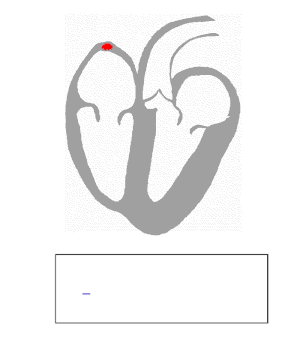Electrical biosignals/examples
Introduction[edit | edit source]
Electrical biosignals can be overall defined as a change in electric current produced by biological activity across a certain tissue or organ.
Examples of electrical biosignals are:
- Electrocardiocraphy (ECG)
- Electromyography (EMG)
- Electroencephalography (EEG)
to name only a few.
I my article however, I am going to briefly explain the function of an Electrocardiography and an Electroencephalography.
Electrocardiography[edit | edit source]
Electrocardiography is a procedure in which the heart's electrical activity is recorded and amplified over a certain period of time. It is a painless and non-invasive procedure in which electrodes are placed on the patient's body in order to detect electrical changes on the skin produced by the heart muscle depolarization and electrical dipoles during each heartbeat. Each beat of the heart is triggered by an electrical impulse. The ECG itself uses these signals in order to determine the heart's rate and regularity as the signals travel through the heart.
Electroencephalography[edit | edit source]
Electroencephalography on the other hand records spontaneous electrical activities of the brain. The EEG is a procedure in which electrodes are placed on the skin and are connected through wires to a computer. Billions of nerve cells in the brain produce tiny electrical signals which are called brain waves. The electrodes detect these signals, they are being amplified and shown as waves on the screen of the computer.
Importance in clinical medicine[edit | edit source]
Electrocardiography is used to diagnose different diseases of the heart, such as a heart attack and cardiac arrhythmias (e.g.: ventricular and articular fibrillation). Apart from diagnosing different diseases, the Electrocardiography also plays a role in preventing diseases since possible cardiac arrhythmias which might lead to a myocardial infarction can be safely detected by the ECG.
Electroencephalography is mainly used as a diagnostic tool for detecting and examing seizure disorders, brain diseases of different nature, sleeping disorders or memory problems. In severe cases it can be also used as a determination of brain death.
Function[edit | edit source]
In a typical 12 lead ECG, ten electrodes are placed on the patient's body. The different positions of the electrodes provide more information about the heart allowing the heart to be viewed from different angles. When a current flow is towards an electrode it causes an upward deflection on the ECG while a current flow away form the electrode produces a downward deflection on the ECG. The current's flow in the heart is divided into different parts. At the beginning of one cardiac cycle the sinus node gives an impulse which activates the atria (P-Wave). The current travels down to the ventricles (QRS Complex) over the atrioventricular node and bundel of HIS and then spreads back over the ventricles which is known as the recovery wave (T-Wave).
The EEG on the other hand, measures voltage variations from ions in the neurons of the brain. The ions interact with the metal of the electrodes detecting a voltage variation between two electrodes which are then recorded as the EEG itself. Since one electrical activity is way too weak to be shown on the EEG, it always reflects the overall amount of eletrical activity of many neurons working at the same time.
Possible risks[edit | edit source]
Electrocardiography is a very safe method which might lead in rare cases to skin irritation. However, risks can be mostly left unattented.
Similar to the Electrocardiography the risks of Electroencephalography are very slim if non existing. In rare cases the use of an EEG on seizure patients may trigger a seizure itself. If the procedure is performed by a spezialized doctor though, he will be trained to safely manage the situation.
References[edit | edit source]
Webpages[edit | edit source]
UCL MEDICAL PHYSICS & BIOMEDICAL ENGINEERING,, et al. E-learning in Biophysics [online]. [cit. 2015-11-20]. <http://www.ucl.ac.uk/medphys/teaching/elearning/elearning_biophysics_2012>.
MICHAEL J, Shea. Electrocardiography [online]. [cit. 2015-11-18]. <http://www.merckmanuals.com/home/heart-and-blood-vessel-disorders/diagnosis-of-heart-and-blood-vessel-disorders/electrocardiography>.
DAVID, Ficker – MAUREEN, Gartner. Electroencephalogram [online]. [cit. 2015-11-20]. <http://www.mayfieldclinic.com/PE-EEG.htm>.
MICHAEL J, Shea. Electrocardiography [online]. [cit. 2015-11-20]. <http://www.merckmanuals.com/professional/cardiovascular-disorders/cardiovascular-tests-and-procedures/electrocardiography-ecg>.
GALE ENCYCLOPEDIA OF MEDICINE,. Electroencephalography [online]. [cit. 2015-11-18]. <http://medical-dictionary.thefreedictionary.com/electroencephalography>.


